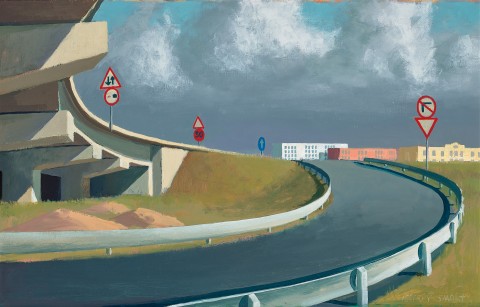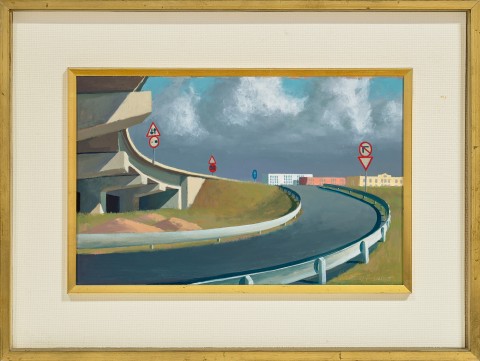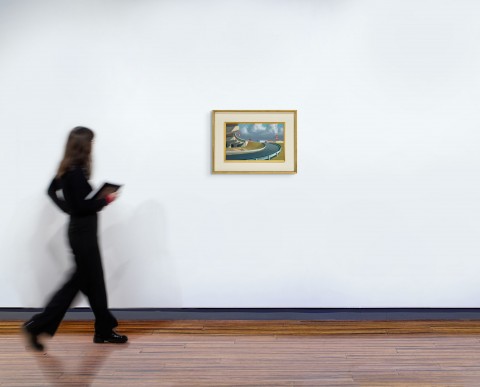(1921 - 2013)
Jeffrey Smart
Study for Approach to E.U.R., 1970
oil on board
Macquarie Galleries, Sydney (label attached verso)
Noel Burns, Sydney, acquired from the above
Thence by descent
Peter Farr Jones, Sydney
Thence by descent
Private collection, New South Wales
Private collection, Sydney
Deutscher~Menzies, Sydney, 14 June 2006, lot 3
Private collection, Melbourne
Jeffrey Smart, Macquarie Galleries, Sydney, 17 – 29 November 1971, cat. 21
Quartermaine, P., Jeffrey Smart, Gryphon Books, Melbourne, 1983, cat. 570, p. 112
McDonald, J., Jeffrey Smart of the '70s and '80s, Craftsman House, Sydney, 1990, cat. 3, p. 156
Approach to E.U.R., 1970, oil on canvas, 60.0 x 92.0 cm, The University of Sydney, Sydney
We are grateful to Stephen Rogers, Archivist for the Estate of Jeffrey Smart, for his assistance with this catalogue entry.
‘I find myself moved by man in this new violent environment. I want to paint this explicitly and beautifully…’1
Undoubtedly one of the great paradoxes of Jeffrey Smart’s immeasurable artistic legacy is that symbols of modernity, urban pressure and activity such as freeways, road signs and trucks should be imbued with an aura of stillness, order and timeless serenity more reminiscent of the Italian Quattrocento painting he so admired. For while drawing inspiration from the urban environment that has flourished in Italy since the Second World War, Smart’s immaculate compositions invariably bear no trace of the chaos or randomness of the world from which they derive. Rather, meticulously distilling his subject of the modern city down to its purely formal qualities in a manner echoing his artistic mentor Cézanne, Smart encourages his audience to see the ‘everyday’ with fresh eyes – to discern beauty in the most unprepossessing, unromantic of subjects.
With its signature motif of a broad sweeping arterial seen from a low perspective and disappearing to an unknowable destination beyond, Study for Approach to the E.U.R., 1970 offers a superb example of Smart’s mastery, encapsulating his unique ability ‘to elevate mundane familiarities… to the status of semi-mystic icons.’2 Undertaken while Smart was living in Rome in a shared apartment on the outskirts with fellow expatriate painters Justin O'Brien, Brian Dunlop and Ian Bent, the composition attests to the artist’s fascination with the nearby ultra-modern E.U.R (Esposizione Universale Roma) estate which he had initially encountered as the bleak setting of Michelangelo Antonioni’s award-winning film, L’Eclisse (1962). Transfixed, Smart would reportedly spend endless hours sketching this sublime, otherworldly ‘city of the future’ with its austere, fascist-inspired architecture that was so loathed by local citizens at the time – eventually transforming such visual notes into fully resolved compositions such as E.U.R. I, 1964 (Newcastle Art Gallery); E.U.R. II, 1965 (private collection) and Approach to E.U.R, 1970 (University of Sydney), for which the present is the only known oil study.
Although unmistakably derived from ‘a moment of enchantment’ glimpsed by Smart during his explorations, Study for Approach to E.U.R does not, however, offer a faithful depiction en plein air of an exact scene, but is rather carefully constructed from the complex weaving of motifs, symbols and disparate elements gleaned from real-life locations and other artworks. Redolent with ambiguity and seductive in its ‘super realism’, indeed the work reveals multiple classic Smart tropes – from the dark brooding sky and inhospitable apartment buildings that loom in the distance, to the ubiquitous road signs and most notably, the dramatic, broad arc of a highway underpass which betrays strong stylistic affinities with some of the artist’s most celebrated works, including the iconic Cahill Expressway, 1962 (National Gallery of Victoria) executed only a few years earlier. In typical Smart fashion, a sense of mystery and disquietude pervades the closely cropped composition – the eerily silent, empty autostrada heightening the incongruity of a scene that would normally evoke noise and congestion.
Like the freeze frame of a film stilled for poetic effect, such compelling images relentlessly assert Smart’s faith in the immutable beauty he perceived amidst the clutter of contemporary life, conveying a rich sense of optimism despite their occasional uncertainties – a poignant reminder that the things which seem upon first glance to reflect a brutality to the soul can become, ironically, a source of wonder.’3
1. Jeffrey Smart, cited in Horton, M. (ed.), Australian Painters of the ’70s, Ure Smith, Sydney, 1975, p. 54
2. Capon, E., ‘Still, Silent, Composed: The Art of Jeffrey Smart' in Jeffrey Smart, Art Gallery of New South Wales, Sydney, 1999, p. 16
3. Pearce, B, ‘Out of Adelaide’ in Jeffrey Smart, ibid., p. 32
VERONICA ANGELATOS


